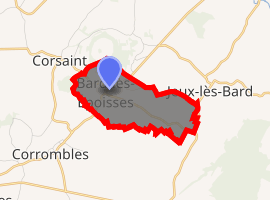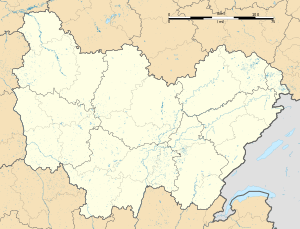Bard-lès-Époisses
Bard-lès-Époisses is a French commune in the Côte-d'Or department in the Bourgogne-Franche-Comté region of eastern France.[2]
Bard-lès-Époisses | |
|---|---|
Location of Bard-lès-Époisses 
| |
 Bard-lès-Époisses  Bard-lès-Époisses | |
| Coordinates: 47°31′56″N 4°13′00″E | |
| Country | France |
| Region | Bourgogne-Franche-Comté |
| Department | Côte-d'Or |
| Arrondissement | Montbard |
| Canton | Semur-en-Auxois |
| Government | |
| • Mayor (2008–2020) | Jean-Michel Massé |
| Area 1 | 3.54 km2 (1.37 sq mi) |
| Population (2017-01-01)[1] | 70 |
| • Density | 20/km2 (51/sq mi) |
| Time zone | UTC+01:00 (CET) |
| • Summer (DST) | UTC+02:00 (CEST) |
| INSEE/Postal code | 21047 /21460 |
| Elevation | 228–365 m (748–1,198 ft) (avg. 247 m or 810 ft) |
| 1 French Land Register data, which excludes lakes, ponds, glaciers > 1 km2 (0.386 sq mi or 247 acres) and river estuaries. | |
The inhabitants of the commune are known as Barrois or Barroises.[3]
Geography
Bard-lès-Époisses is located some 14 km south-west of Montbard and 5 km north-east of Époisses. Access to the commune is by the D4 road from Athie in the north-east which passes through the heart of the commune and the village and continues south-west to Corrombles. The D4H comes from Corsaint in the west and passes through the length of the commune, intersecting the D4 in the village, and continues east to join the D4M south-west of Jeux-lès-Bard. Apart from some forest in the north the commune is almost entirely farmland.[4][5]
The Ru d'Acier stream flows through the east of the commune from south-west to north-east and continues to join the Ruisseau de la Prée north-east of Jeux-lès-Bard.[4]
History
For many centuries the commune was called Bar.
Bar was an annex of Torcy with its patron Saint Matthew. Attached to the diocese of Langres, the parish had 3 parts: Bar, Jeux (formerly Jox and Jovum), and a portion of Corrombles called the Rue de Bar. The parish had 300 communicants. The Lord was the bishop of Langres then the abbot of Moutiers-Saint-Jean to whom the church was given in 1141. The Town Hall fief was given to Charles Lanneau de Marey, Knight of Saint Louis. Among the older families there are the Drouhin. P. Drouhin was Châtelain of Vieux-Château in 1409.
Bard-lès-Époisses appears as Bard on the 1750 Cassini Map[6] and the same on the 1790 version.[7]
Administration
| From | To | Name | Party | Position |
|---|---|---|---|---|
| 2001 | 2020 | Jean Michel Massé |
(Not all data is known)
Demography
In 2010 the commune had 54 inhabitants. The evolution of the number of inhabitants is known from the population censuses conducted in the commune since 1793. From the 21st century, a census of communes with fewer than 10,000 inhabitants is held every five years, unlike larger communes that have a sample survey every year.[Note 1]
| 1793 | 1800 | 1806 | 1821 | 1831 | 1836 | 1841 | 1846 | 1851 |
|---|---|---|---|---|---|---|---|---|
| 538 | 240 | 243 | 200 | 200 | 214 | 189 | 190 | 188 |
| 1856 | 1861 | 1866 | 1872 | 1876 | 1881 | 1886 | 1891 | 1896 |
|---|---|---|---|---|---|---|---|---|
| 170 | 184 | 169 | 155 | 149 | 145 | 138 | 142 | 136 |
| 1901 | 1906 | 1911 | 1921 | 1926 | 1931 | 1936 | 1946 | 1954 |
|---|---|---|---|---|---|---|---|---|
| 142 | 112 | 123 | 105 | 97 | 101 | 93 | 82 | 96 |
| 1962 | 1968 | 1975 | 1982 | 1990 | 1999 | 2006 | 2010 | - |
|---|---|---|---|---|---|---|---|---|
| 91 | 95 | 90 | 72 | 66 | 67 | 75 | 54 | - |

Economy
The hill slopes were covered with vines in the early 20th century but the rural exodus and the consequent reduction in population led the remaining farmers to focus their activity on livestock grazing and mixed farming in the plains, leaving the hills area mostly fallow.
Notable people linked to the commune
- Étienne Bouhot (8 August 1780 – 17 July 1862), painter, was born in the commune.
- Victor de Lanneau (25 December 1758 – 1830), defrocked priest and teacher, was born in the commune.
See also
Notes and references
Notes
- At the beginning of the 21st century, the methods of identification have been modified by Law No. 2002-276 of 27 February 2002 Archived 6 March 2016 at the Wayback Machine, the so-called "law of local democracy" and in particular Title V "census operations" allows, after a transitional period running from 2004 to 2008, the annual publication of the legal population of the different French administrative districts. For communes with a population greater than 10,000 inhabitants, a sample survey is conducted annually, the entire territory of these communes is taken into account at the end of the period of five years. The first "legal population" after 1999 under this new law came into force on 1 January 2009 and was based on the census of 2006.
References
- "Populations légales 2017". INSEE. Retrieved 6 January 2020.
- Bard-lès-Époisses on Lion1906
- Inhabitants of Côte-d'Or (in French)
- Bard-lès-Époisses on Google Maps
- Bard-lès-Époisses on the Géoportail from National Geographic Institute (IGN) website (in French)
- Bard on the 1750 Cassini Map
- Bard on the 1790 Cassini Map
- List of Mayors of France (in French)
| Wikimedia Commons has media related to Bard-lès-Époisses. |